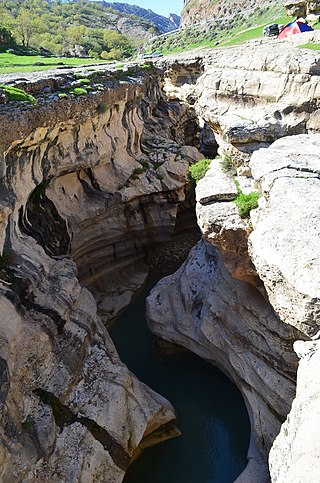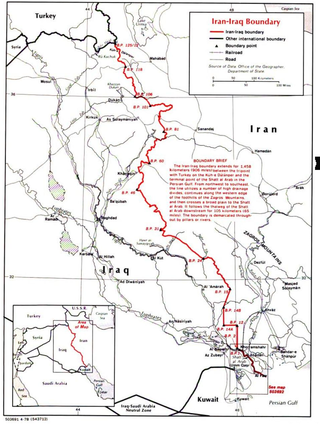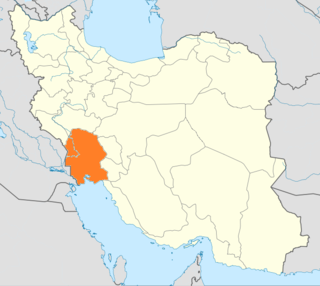
Ilam Province is one of the 31 provinces of Iran. It is located in the western part of the country in Region 4 and covers 20,164.11 km2 (7,785.41 sq mi). It shares 425 km (264 mi) of the border with Iraq, and also bordering on the provinces of Kermanshah, Lorestan, and Khuzestan. The largest city and also the provincial capital is Ilam.

Khuzestan province is one of the 31 provinces of Iran. Located in the southwest of the country, the province borders Iraq and the Persian Gulf. Its capital is Ahvaz and it covers an area of 63,238 square kilometres (24,416 sq mi). Since 2014, it has been part of Iran's Region 4.
Mehran is a city in the Central District of Mehran County, Ilam province, Iran, and serves as both capital of the county and of the district.
Qasr-e Shirin also Romanized as Qasr-e Širin and Qasr-e-Shīrīn; also known as Ghasr-ī-Shīrīn and Ghasr-Shīrīn; Kurdish: قەسری شیرین, romanized: Qesrî Şîrîn, is a city in the Central District of Qasr-e Shirin County, Kermanshah province, Iran, serving as capital of both the county and the district. Its population in 2016 was 18,473. It is a Free-trade zone (FTZ) and is populated by Kurds.

The SecondBattle of Khorramshahr, also known in Iran as the Liberation of Khorramshahr was the Iranian recapture of the city of Khorramshahr on 24 May 1982, during the Iran–Iraq War. The city had been captured by the Iraqis earlier in the war, on 26 October 1980, shortly after the Iraqi invasion of Iran. The successful retaking of the city was part of Iran's Operation Beit ol-Moqaddas. It is perceived as a turning point in the war; and the liberation of the city is annually celebrated in Iran on 24 May.

Mohsen Mirdamadi is an Iranian academic and politician. He is the Deputy Secretary General of "Ettehad-e Mellat", the largest pro-reform political party in Iran. After the 2009 Iranian Presidential Elections, he was sentenced to and put to 6 years of prison, among other leaders of reformist party. Previously, he was elected as a member of the Parliament of Iran from 2000 until 2004, during which time he chaired the parliament's Commission of National Security and Foreign Policy. He received his PhD from Cambridge University in 1997 in Foreign Relations. He has served in various political roles since the 1979 Iranian Revolution, including serving as the governor of Khuzestan Province in the last years of the Iran-Iraq war. He was among the organizers of the 1979 Iran hostage crisis.

Parliamentary elections were held in Iran on 18 February 2000, with a second round on 5 May. The result was a solid victory for 2nd of Khordad Front and its allies, the reformist supporters of President Mohammad Khatami.

The Iran–Iraq border runs for 1,599 km (994 mi) from the tripoint with Turkey in the north down to the Shatt al-Arab waterway and out to the Persian Gulf in the south. Although the boundary was first determined in 1639, certain disputes continue, particularly surrounding navigation on the Shatt al-Arab.
Operation Dawn 3 or Operation Valfajr-3 was an operation during the Iran–Iraq War. The operation was launched in the range of "semi-extensive operation" located in the general area of Mehran ; and eventually led in the liberation of Mehran by Iranian forces. Iran's goals of the operation were as follows:
These are the orders of battle of the Iraqi and Iranian armies for the start of the Iran–Iraq War in 1980. The data is drawn from the Air Combat Information Group's Arabian Peninsula and Persian Gulf Database.

The First Battle of Khorramshahr was a major battle in the Iran–Iraq War, beginning shortly after the Iraqi invasion of Iran in September 1980. Amidst the gruelling urban warfare in and around the city, Khorramshahr came to be referred to by the Iranians as Khuninshahr, as both sides had suffered heavy casualties in combat. It was the single largest urban battle of the Iran–Iraq war.

Parliamentary elections were held in Iran on 13 March 1980, with a second round on 9 May. They were the first elections to the Majlis since the overthrow of the Shah, and were contested to a considerable degree on a party basis.

Parliamentary elections were held in Iran on 8 April 1988, with a second round on 13 May. The result was a victory for leftist politicians who later emerged as reformists. The number of clerics elected to the Majlis was reduced by over a third.

Parliamentary elections were held in Iran in 1952 to elect the 17th Iranian Majlis.
Khosravi, also Romanized as Khosravī and Khosrovī; also known as Khosrowvī, Khūsrawī, and Khūsrovī, is a village in, and the capital of, Alvand Rural District of the Central District of Qasr-e Shirin County, Kermanshah province, Iran. The village is populated by Kurds.

General elections were held in Bahrain for the first time on 12 December 1973. 30 seats out of the 44-seated unicameral National Assembly were contested, the other 14 were ex officio. Of the 24,883 registered voters, 19,509 cast a ballot, giving a voter turnout of 78.4%.

Constitutional Convention elections were held in Iran on 3 and 4 August 1979. The result was a victory for the Islamic Republican Party. There were 10,784,932 votes cast in the elections, marking 51.71% turnout. Of all members elected, 68% were clerics.

The 1979 Khuzestan uprising was one of the nationwide uprisings in Iran, which erupted in the aftermath of the Iranian Revolution. The unrest was fed by Arab demands for autonomy. The uprising was effectively quelled by Iranian security forces, resulting in more than a hundred people on both sides killed.
Fakkeh is a place at the northwest of Khuzestan and southeast of Ilam province in Iran. The north of Fakkeh belongs to Dehloran County, Ilam and the south of Fakkeh is belong to Dasht-e Azadegan County, Khuzestan. Also, this place is a border region between Iran and Iraq. There are a lot of sandy land in the Fakkeh area and it has dry weather.
The Third Day is the sixth film of Mohammad Hossein Latifi as a director and produced in 2007. This film is based on the documentary of the same name by Hamid Zargarnejad.The film stars Pouria Poursorkh, Baran Kosari and Hamed Behdad. The film shows the last days of battle of Khorramshahr.














